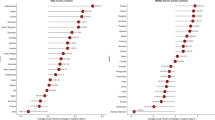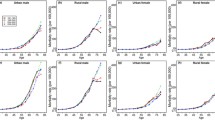The purpose of this study was to examine the incidence pattern of esophageal eancer in Connecticut (USA) during the past decades, and to identify components of birth cohort, period, and age as determinants of the observed time trends by regression modelling. This study is based on all of the esophageal cancer cases reported to the Connecticut Tumor Registry between 1935 and 1989. A total of 6,310 incident cases were included. Results indicate that among males, the overall age-adjusted incidence rate of esophageal cancer increased after 1935 and peaked between 1955 and 1959. Since then, incidence rates have been relatively stable. Among females, the overall esophageal cancer rate has not changed markedly since 1935. Analysis by histologic type indicates that the incidence rate of squamous cell carcinoma has been declining in this population; adenocarcinoma, however, showed a continuous increase. A fivefold increase among males and a threefold increase among females were observed for adenocarcinoma of the esophagus between 1970 and 1989. If cancers of the esophagus and gastric cardia are considered together, the incidence rate of adenocarcinoma exceeds that of squamous cell carcinoma among males during 1985–89. The observed increasing trend for adenocarcinoma of the esophagus is mainly from cancers arising in the lower third of the esophagus and primarily among Whites, especially White males. The results from regression modeling indicate that both period and birth cohort may have contributed to the observed increasing trend, and adenocarcinoma of the esophagus is likely to increase continuously in this population in the coming years.
Similar content being viewed by others
References
Blot WJ, Devesa SS, Kneller RW, Fraumeni JFJr. Rising incidence of adenocarcinoma of the esophagus and gastric cardia. JAMA 1991; 265: 1287–9.
Yang PC, Davis S. Incidence of cancer of the esophagus in the US by histologic type. Cancer 1988; 61: 612–7.
Powell J, McConkey CC. Increasing incidence of adenocarcinoma of the gastric cardia and adjacent sites. Br J Cancer 1990; 62: 440–3.
Levi F, La Vecchia C, Te VC. Descriptive epidemiology of adenocarcinomas of the cardia and distal stomach in the Swiss Canton of Vaud. Tumori 1990; 76: 167–71.
Levi F, La Vecchia C. Adenocarcinoma of the esophagus in Switzerland. JAMA 1991; 22: 2960.
Hesketh PJ, Clapp RW, Doos WG, Splecher SJ. The increasing frequency of adenocarcinoma of the esophagus. Cancer 1989; 64: 526–30.
Wang HH, Antonioli DA, Goldman H. Comparative features of esophageal and gastric adenocarcinomas: recent changes in type and frequency. Human Pathol 1986; 17: 482–7.
Kalish RJ, Clancy PE, Orringer MB, Appelman HD. Clinical, epidemiologic, and morphologic comparison between adenocarcinomas arising in Barrett's esophageal mucosa and in the gastric cardia. Gastroenterology 1984; 86: 461–7.
Zheng T, Mayne ST, Flannery J. The time trends of multiple myeloma in Connecticut, 1935–1987. Int J Cancer 1992; 50: 163–4.
Zheng T, Mayne ST, Holford TR, Boyle P, Flannery J. Epidemiology of non-Hodgkin's lymphoma in Connecticut, 1935–1988. Cancer (in press).
World Health Organization. ICD-O, International Classification of Diseases for Oncology, 1st edn. Geneva: WHO, 1976.
Holford TR, Zheng T, Mayne ST, McKay LA. Time trends of non-Hodgkin's lymphoma: are they real? What do they mean? Cancer Res (in press).
Holford TR. The estimation of age, period and cohort effects for vital rates. Biometrics 1983; 39: 311–24.
Holford TR. Understanding the effects of age, period, and cohort on incidence and mortality rates. Ann Rev Public Health 1991; 12: 425–57.
GLIM Working Party. In. The GLIM System, Release 3.77. Oxford: Numerical Algorithms Group, Ltd, 1987.
Clayton D, Schifflers E. Models for temporal variation in cancer rates. I. Age-period and age-cohort models. Stats In Med 1987; 6: 449–67.
Clayton D, Schifflers E. Models for temporal variation in cancer rates. II. Age-period and age-cohort models. Stats In Med 1987; 6: 469–81.
Bosch A, Frias Z, Caldwell WL. Adenocarcinoma of the esophagus. Cancer 1979; 43: 1557–61.
Webb JN, Busuttil A. Adenocarcinoma of the esophagus and esophagogastric junction. Br J Surg 1978; 65: 475–9.
Levine MS, Caroline D, Thompson JJ, et al. Adenocarcinoma of the esophagus: relationship to Barrett mucosa. Radiology 1984; 150: 305–9.
Enterline H, Thompson J. Pathology of the Esophagus. Barrett's Metaplasia and Adenocarcinoma. New York: Springer-Verlag Inc., 1984: 109–27.
Rubio CA, Aberg B. Barrett's mucosa in conjunction with squamous carcinoma of the esophagus. Cancer 1991; 68: 583–6.
Haggitt RC, Tryzelaar J, Ellis FHJr, Colcher H. Adenocarcinoma complicating columnar epithelium-lined (Barrett's) esophagus. Am J Clin Pathol 1978; 70: 1–5.
Skinner DB, Walther BC, Riddell RH, et al. Barrett's esophagus: comparison of benign and malignant cases. Ann Surg 1983; 198: 554–65.
Smith RL, Boitnott JK, Hamilton SR, Rogers EL. The spectrum of carcinoma arising in Barrett's esophagus. Am J Surg Pathol 1984; 8: 563–73.
Thompson JJ, Zinsser KR, Enterline HT. Barrett's metaplasia and adenocarcinoma of the esophagus and gastroesophageal junction. Hum Pathol 1983; 14: 42–61.
MacDonald WC, MacDonald JB. Adenocarcinoma of the esophagus and/or gastric cardia. Cancer 1987; 60: 1094–8.
Bennett JR. Medical therapy for gastro-oesophageal reflux. In: Hennessy TPJ, Cuschieri A, Bennett JR, eds. Reflux Oesophagitis. London: Butterworth, 1989: 123–41.
Jamieson GG, Duranceau A. Gastroesophageal Reflux. Philadelphia, PA: WB Saunders, 1988.
Day JP, Richter JE. Medical and surgical conditions predisposing to gastroesophageal reflux disease. Gastroenterol Clin N Am 1990; 19: 587–697.
Wynder EL, Mabuchi K. Etiological and environmenal factors. JAMA 1973; 226: 1546–8.
International Agency for Research on Cancer. Tobacco Smoking. Lyon, France: IARC 1986; IARC Monogr Eval Carginog Risk Chem Humans, Vol. 38.
Day NE, Munoz N. Esophagus. In: Schottenfeld D, Fraumeni JF, eds. Cancer Epidemiology and Prevention. Philadelphia, PA: WB Saunders, 1982: 596–623.
Day NE, Munoz N, Ghadirian P. Epidemiology of esophageal cancer: a review. In: Correa P, Haenszel W, eds. Epidemiology of Cancer of the Digestive Tract. The Hague: Nijhoff, 1982: 21–5.
Devesa SS, Silverman DT, Young JLJr, et al. Cancer incidence and mortality trends among whites in the United States: 1947–84. JNCI 1987; 79: 701–70.
Moller H, Boyle P, Maisonneuve P, et al. Changing mortality from esophageal cancer in males in Denmark and other European countries in relation to changing levels of alcohol consumption. Cancer Causes Control 1990; 1: 181–8.
Mahaney FXJr. Lung cancer rates in white males levelling off. JNCI 1992; 84: 83–4.
Ernster VL. Women, smoking, cigarette advertising and cancer. In: Stellman SD, eds. Women and Cancer. New York: The Haworth Press, Inc., 1987: 217–35.
Devesa SS, Shaw GL, Blot WJ. Changing patterns of lung cancer incidence by histological type. Cancer Epidemiol Biomark Prevent 1991; 1: 29–34.
Devesa SS, Blot WJ, Fraumeni JFJr. Declining lung cancer among young men and women in the United States: a cohort analysis. JNCI 1989; 81: 1568–71.
Auerbach O, Garfinkel L. The changing pattern of lung carcinoma. Cancer 1991; 68: 1973–7.
Tuyns AJ. Incidence trends of laryngeal cancer in relation to national alcohol and tobacco consumption. In: Magnus K, eds. Trends in Cancer Incidence: Causes and Practical Implications. Washington, DC: Hemisphere, 1982; 199–214.
Roush GC, Holford TR, Schymura MJ, et al. Larynx. In: Cancer Risk and Incidence Trends: The Connecticut Perspective. Washington, DC: Hemisphere, 1987: 173–86.
International Agency for Research on Cancer. Alcohol Drinking. Lyon, France: IARC, 1988, IARC Monog Eval Carcinog Risk Chem Humans, Vol. 44.
Pottern LM, Morris LE, Blot WJ, et al. Esophageal cancer among Black men in Washington DC. I. Alcohol, tobacco, and other risk factors. JNCI 1981; 67: 777–83.
Levi F, Ollyo JB, La Vecchia C, Boyle P, et al. The consumption of tobacco, alcohol and the risk of adenocarcinoma in Barrett's oesophagus. Int J Cancer 1990; 45: 852–4.
Li JY, Ershow AG, Chen ZJ, et al. A case-control study of cancer of the esophagus and gastric cardia in Linxian. Int J Cancer 1989; 43: 755–61.
Mayne ST, Graham S, Zheng T. Dietary retinol: prevention or promotion of carcinogenesis in humans? Cancer Causes Control 1991; 2: 443–50.
Tuyns AJ, Riboli E, Doornbos G, Pequignot G. Diet and esophageal cancer in Calvados (France). Nutr Cancer 1987; 9: 81–92.
Decarli A, Liati P, Negri E, Franceschi S, La Vecchia C. Vitamin A and other dietary factors in the etiology of esophageal cancer. Nutr Cancer 1987; 10: 29–37.
Brown LM, Blot WJ, Schuman SH, et al. Environmental factors and high risk of esophageal cancer among men in Coastal South Carolina. JNCI 1988; 80: 1620–5.
Graham S, Marshall J, Haughey B, et al. Nutritional epidemiology of cancer of the esophagus. Am J Epidemiol 1990; 131: 454–67.
Van Rensberg SJ, Krukger EF, Louw MEJ, duPlessis JP. Vitamin A status and esophageal cancer risk: epidemiologic and experimental evidence for a positive association. Nutr Rep Int 1981; 24: 1123–31.
Additional information
Drs Zheng, Mayne, and Holford, Mr Liu, Ms Chen, and Mr Mador are from the Department of Epidemiology and Publie Health, Yale University School of Medicine, New Haven, CT, USA. Dr Boyle is in the Division of Epidemiology and Biostatistics, European Institute of Oncology, Milan, Italy. Mr Flannery is in the Connecticut Tumor Registry, Hartford, CT, USA. Address correspondence to Dr Zheng, Cancer Prevention Research Unit for Connecticut, Yale University School of Medicine, 26 High Street, New Haven, CT 06510, USA. This study was supported by NIH grant # CA-42101.
Rights and permissions
About this article
Cite this article
Zheng, T., Mayne, S.T., Holford, T.R. et al. Time trend and age-period-cohort effects on incidence of esophageal cancer in Connecticut, 1935–89. Cancer Causes Control 3, 481–492 (1992). https://doi.org/10.1007/BF00051361
Received:
Accepted:
Issue Date:
DOI: https://doi.org/10.1007/BF00051361




